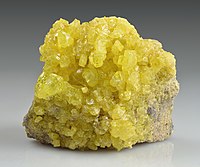
Photo from wikipedia
Sulfonate esters, a class of potentially mutagenic drug impurities, are strictly regulated in pharmaceuticals. On the other hand, sulfite esters and sulfones, analogs of sulfonate esters, have limited safety concerns.… Click to show full abstract
Sulfonate esters, a class of potentially mutagenic drug impurities, are strictly regulated in pharmaceuticals. On the other hand, sulfite esters and sulfones, analogs of sulfonate esters, have limited safety concerns. However, previously developed analytical methods for sulfonate ester identification cannot be used to differentiate sulfonate esters from the isomeric sulfite esters and sulfones. A tandem mass spectrometric method is introduced here for the differentiation of these compounds. Diisopropoxymethylborane (DIMB) reacts with protonated sulfonate esters, sulfite esters, and sulfones (and many other compounds) in the gas phase to form the product ion [M + H + DIMB - CH3CH(OH)CH3]+. Upon collision-activated dissociation (CAD), these product ions generate diagnostic fragment ions that enable the differentiation of sulfonate esters, sulfite esters, and sulfones from each other. For example, SO2 elimination enabled the unambiguous identification of sulfite esters. On the other hand, elimination of CH3B═O followed by elimination of (CH3)2C═O was only observed for sulfonate esters. Neither type of diagnostic fragment ions was detected for the products of sulfones. However, the product ions formed for sulfones with an additional hydroxyl substituent underwent the elimination of another CH3CH(OH)CH3 molecule, which enabled their identification. Finally, ion-molecule reactions of DIMB with various other functionalities were also examined. Some of them yielded the product ions [M + H + DIMB - CH3CH(OH)CH3]+ but none of these product ions underwent the diagnostic CAD reactions discussed above. Quantum chemical calculations were employed to explore the mechanisms of the reactions. The limits of detection for the diagnostic ion-molecule reaction product ions in high-performance liquid chromatography (HPLC)/mass spectrometry (MS2) experiments were found to range from 0.075 to 1.25 nmol.
Journal Title: Analytical chemistry
Year Published: 2022
Link to full text (if available)
Share on Social Media: Sign Up to like & get
recommendations!